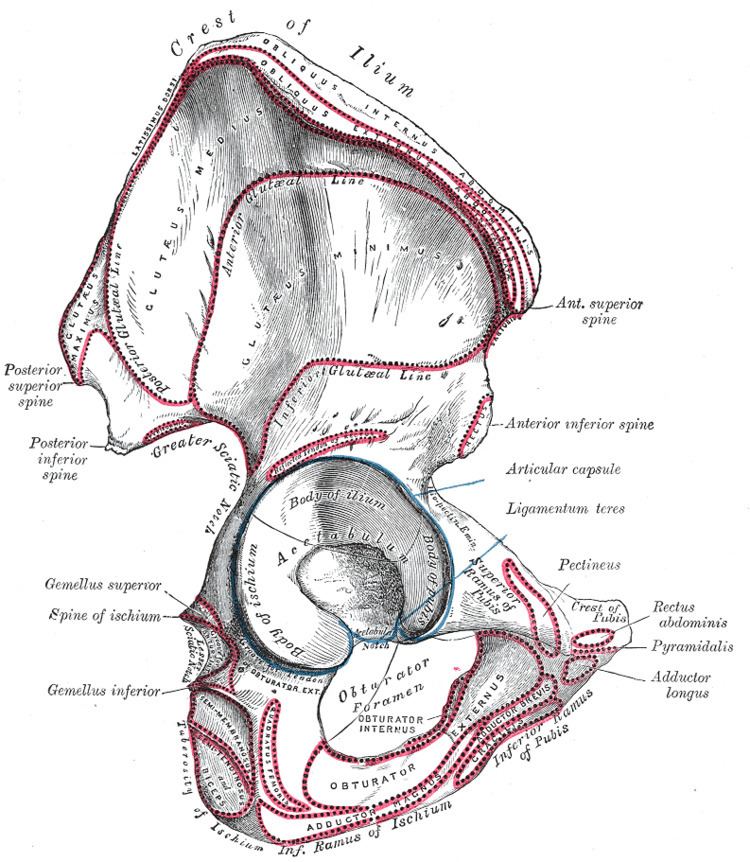TA A02.5.01.104 | Dorlands/Elsevier a_21/12118073 FMA 42826 | |
 | ||
The wing of ilium (or ala) is the large expanded portion which bounds the greater pelvis laterally. It presents for examination two surfaces—an external and an internal—a crest, and two borders—an anterior and a posterior.
Contents
Internal surface of the ala
The internal surface of the ala is bounded above by the crest, below, by the arcuate line; in front and behind, by the anterior and posterior borders.
It presents a large, smooth, concave surface, called the iliac fossa, which gives origin to the Iliacus and is perforated at its inner part by a nutrient canal; and below this a smooth, rounded border, the arcuate line, which runs downward, forward, and medialward.
Behind the iliac fossa is a rough surface, divided into two portions, an anterior and a posterior. The anterior surface (auricular surface), so called from its resemblance in shape to the ear, is coated with cartilage in the fresh state, and articulates with a similar surface on the side of the sacrum.
The posterior portion, known as the iliac tuberosity, is elevated and rough, for the attachment of the posterior sacroiliac ligaments and for the origins of the Sacrospinalis and Multifidus.
Below and in front of the auricular surface is the preauricular sulcus, more commonly present and better marked in the female than in the male; to it is attached the pelvic portion of the anterior sacroiliac ligament.
Crest of the ilium
The crest of the ilium is convex in its general outline but is sinuously curved, being concave inward in front, concave outward behind.
It is thinner at the center than at the extremities, and ends in the anterior and posterior superior iliac spines. The surface of the crest is broad, and divided into external and internal lips, and an intermediate line.
About 5 cm. behind the anterior superior iliac spine there is a prominent tubercle on the outer lip.
To the external lip are attached the Tensor fasciæ latæ, Obliquus externus abdominis, and Latissimus dorsi, and along its whole length the fascia lata; to the intermediate line the Obliquus internus abdominis; to the internal lip, the fascia iliaca, the Transversus abdominis, Quadratus lumborum, Sacrospinalis, and Iliacus.
Anterior border of the ala
The anterior border of the ala is concave. It presents two projections, separated by a notch.
Of these, the uppermost, situated at the junction of the crest and anterior border, is called the anterior superior iliac spine; its outer border gives attachment to the fascia lata, and the Tensor fasciæ latæ, its inner border, to the Iliacus; while its extremity affords attachment to the inguinal ligament and gives origin to the sartorius
Beneath this eminence is a notch from which the Sartorius takes origin and across which the lateral femoral cutaneous nerve passes.
Below the notch is the anterior inferior iliac spine, which ends in the upper lip of the acetabulum; it gives attachment to the straight tendon of the Rectus femoris and to the iliofemoral ligament of the hip-joint.
Medial to the anterior inferior spine is a broad, shallow groove, over which the Iliacus and Psoas major pass.
This groove is bounded medially by an eminence, the iliopectineal eminence, which marks the point of union of the ilium and pubis.
Posterior border of the ala
The posterior border of the ala, shorter than the anterior, also presents two projections separated by a notch, the posterior superior iliac spine and the posterior inferior iliac spine.
The former serves for the attachment of the oblique portion of the posterior sacroiliac ligaments and the Multifidus; the latter corresponds with the posterior extremity of the auricular surface.
Below the posterior inferior spine is a deep notch, the greater sciatic notch.
